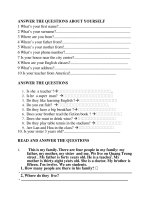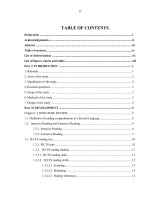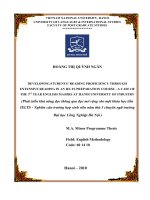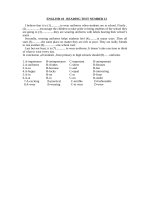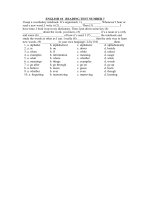AUTHENTIC READING TEST COLLECTIONS IELTS
Bạn đang xem bản rút gọn của tài liệu. Xem và tải ngay bản đầy đủ của tài liệu tại đây (1.85 MB, 259 trang )
www.ngocbach.com
AUTHENTIC READING
TEST COLLECTIONS
IELTS NGOC BACH
www.ngocbach.com
Page 0
CONTENT
Mental gymnastics ................................................................................................ 3
Food of thought ................................................................................................... 10
World Ecotourism in the developing courtiers ................................................... 17
Museum Blockbuster .......................................................................................... 24
Keep a watchful eye on the bridges .................................................................... 31
Knowledge in medicine ...................................................................................... 37
Spider Silk ........................................................................................................... 43
The Adolescents .................................................................................................. 49
Coral reefs ........................................................................................................... 55
Griffith and American films................................................................................ 62
Water Filter ......................................................................................................... 70
Memory Decoding .............................................................................................. 76
Smell and Memory .............................................................................................. 83
Language Strategy in Multinational Company ................................................... 90
Mass Production .................................................................................................. 97
The dugong: sea cow......................................................................................... 105
Tea and Industrial Revolution ........................................................................... 119
Koalas ................................................................................................................ 125
TV Addiction 2 ................................................................................................. 131
The history of salt ............................................................................................. 138
London Swaying Footbridge............................................................................. 144
The reconstruction of community in Talbot Park, Auckland ........................... 148
Art in Iron and Steel .......................................................................................... 153
Stealth Forces in weight Loss ........................................................................... 158
What are Dreams? ............................................................................................. 164
The Exploration of Mars ................................................................................... 170
Company Innovation ......................................................................................... 176
Development of Public management theory ..................................................... 181
Ancient Chinese Chariots ................................................................................. 192
www.ngocbach.com
Page 1
The concept of childhood in the western countries .......................................... 197
Animal minds: Parrot Alex ............................................................................... 202
The History of building Telegraph lines ........................................................... 208
Implication of False Belief Experiments .......................................................... 213
Fossil files ―The Paleobiology Database‖ ........................................................ 218
Paper or Computer? .......................................................................................... 224
Organic farming and chemical fertilizers ......................................................... 231
Internal and External Marketing ....................................................................... 237
Texting! The television 2 .................................................................................. 242
The Beginning of Football! ............................................................................... 248
Corporate Social Responsibility ....................................................................... 253
www.ngocbach.com
Page 2
MENTAL GYMNASTICS
A.
The working day has just started at the head office of Barclays
Bank in London. Seventeen staff are helping themselves to a buffet breakfast as
young psychologist Sebastian Bailey enters the room to begin the morning‘s
training session. But this is no ordinary training session. He‘s not here to
sharpen their finance or management skills. He‘s here to exercise their brains.
B.
Today‘s workout, organized by a company called the Mind Gym in
London, entitled ―having presence‖. What follows is an intense 90-minute
session in which this rather abstract concept is gradually broken down into a
concrete set of feelings, mental tricks and behaviors. At one point the bankers
are instructed to shut their eyes and visualize themselves filling the room and
then the building. They finish up by walking around the room acting out various
levels of presence, from low-key to over the top.
C.
It‘s easy to poke fun. Yet similar mental workouts are happening in
corporate seminar rooms around the globe. The Mind Gym alone offers some
70 different sessions, including ones on mental stamina, creativity for logical
thinkers and ―zoom learning‖. Other outfits draw more directly on the exercise
analogy, offering ―neurotics‖ courses with names like ―brain sets‖ and ―cerebral
fitness‖. Then there are books with titles like Pumping Ions, full of brainteasers
that claim to ―flex your mind‖, and software packages offering memory and
spatial-awareness games.
D.
D But whatever the style, the companies‘ sales pitch is invariably
the same - follow our routines to shape and sculpt your brain or mind, just as
you might tone and train your body. And, of course, they nearly all claim that
their mental workouts draw on serious scientific research and thinking into how
the brain works.
E.
One outfit, Brainergy of Cambridge, Massachusetts (motto:
―Because your grey matter matters‖) puts it like this: ―Studies have shown that
mental exercise can cause changes in brain anatomy and brain chemistry which
www.ngocbach.com
Page 3
promote increased mental efficiency and clarity. The neuroscience is cuttingedge.‖ And on its website, Mind Gym trades on a quote from Susan Greenfield,
one of Britain‘s best known neuroscientists: ―It‘s a bit like going to the gym, if
you exercise your brain it will grow.‖
F.
Indeed, the Mind Gym originally planned to hold its sessions in a
local health club, until its founders realized where the real money was to be
made. Modem companies need flexible, bright thinkers and will seize on
anything that claims to create them, especially if it looks like a quick fix backed
by science. But are neurotic workouts really backed by science? And do we
need them?
G.
Nor is there anything remotely high-tech about what Lawrence
Katz, coauthor of Keep Your Brain Alive, recommends. Katz, a neurobiologist
at Duke University Medical School in North Carolina, argues that just as many
of us fail to get enough physical exercise, so we also lack sufficient mental
stimulation to keep our brain in trim. Sure we are busy with jobs, family and
housework. But most of this activity is repetitive routine. And any leisure time
is spent slumped in front of the TV.
H.
So, read a book upside down. Write or brush your teeth with your
wrong hand. Feel your way around the room with your eyes shut. Sniff vanilla
essence while listening intently to orchestral music. Anything, says Katz, to
break your normal mental routine. It will help invigorate your brain,
encouraging its cells to make new connections and pump out neurotrophins,
substances that feed and sustain brain circuits.
I.
Well, up to a point it will. ―What I‘m really talking about is brain
maintenance rather than bulking up your IQ,‖ Katz adds. Neurotics, in other
words, is about letting your brain fulfill its potential. It cannot create superbrains. Can it achieve even that much, though? Certainly the brain is an organ
that can adapt to the demands placed on it. Tests on animal brain tissue, for
example, have repeatedly shown that electrically stimulating the synapses that
connect nerve cells thought to be crucial to learning and reasoning, makes them
www.ngocbach.com
Page 4
stronger and more responsive. Brain scans suggest we use a lot more of our grey
matter when carrying out new or strange tasks than when we‘re doing wellrehearsed ones. Rats raised in bright cages with toys sprout more neural
connections than rats raised in bare cages - suggesting perhaps that novelty and
variety could be crucial to a developing brain. Katz, And neurologists have
proved time and again that people who lose brain cells suddenly during a stroke
often sprout new connections to compensate for the loss especially if they
undergo extensive therapy to overcome any paralysis.
J.
Guy Claxton, an educational psychologist at the University of
Bristol, dismisses most of the neurological approaches as ―neuron-babble‖.
Nevertheless, there are specific mental skills we can loam, he contends.
Desirable attributes such as creativity, mental flexibility, and even motivation,
are not the fixed faculties that most of us think. They are thought habits that can
be learned. The problem, says Claxton, is that most of us never get proper
training in these skills. We develop our own private set of mental strategies for
tackling tasks and never learn anything explicitly. Worse still, because any
learned skill - even driving a car or brushing our teethquickly sinks out of
consciousness, we can no longer see the very thought habits we‘re relying upon.
Our mental tools become invisible to us.
K.
Claxton is the academic adviser to the Mind Gym. So not
surprisingly,
the company espouses his solution - that we must return our thought patterns to
a conscious level, becoming aware of the details of how we usually think. Only
then can we start to practise better thought patterns, until eventually these
become our new habits. Switching metaphors, picture not gym classes, but
tennis or football coaching.
L.
In practice, the training can seem quite mundane. For example, in
one of the eight different creativity workouts offered by the Mind Gym entitled ―creativity for logical thinkers‖ one of the mental strategies taught is to
make a sensible suggestion, then immediately pose its opposite. So, asked to
www.ngocbach.com
Page 5
spend five minutes inventing a new pizza, a group soon comes up with no
topping, sweet topping, cold topping, price based on time of day, flat-rate prices
and so on.
M.
Bailey agrees that the trick is simple. But it is surprising how few
such tricks people have to call upon when they are suddenly asked to be
creative: ―They tend to just label themselves as uncreative, not realizing that
there are techniques that every creative person employs.‖ Bailey says the aim is
to introduce people to half a dozen or so such strategies in a session so that what
at first seems like a dauntingly abstract mental task becomes a set of concrete,
learnable behaviors. He admits this is not a short cut to genius. Neurologically,
some people do start with quicker circuits or greater handling capacity.
However, with the right kind of training he thinks we can dramatically increase
how efficiently we use it.
N.
It is hard to prove that the training itself is effective. How do you
measure a change in an employee‘s creativity levels, or memory skills? But
staff certainly report feeling that such classes have opened their eyes. So,
neurological boosting or psychological training? At the moment you can pay
your money and take your choice. Claxton for one believes there is no reason
why schools and universities shouldn‘t spend more time teaching basic thinking
skills, rather than trying to stuff heads with facts and hoping that effective
thought habits are somehow absorbed by osmosis.
www.ngocbach.com
Page 6
Questions 1 - 5
Do the following statements agree with the information given in Reading
Passage
In boxes 1 - 5 on your answer sheet, write
YES
if the statement agree with the views of the writer
NO
if the statement contradicts the view of the writer
NOT GIVEN
if it is impossible to say what the writer thinks about this
1 Mind Gym coach instructed employees to imagine that they are
the building.
2 Mind Gym uses the similar marketing theory that is used all
round 3 Susan Greenfield is the founder of Mind Gym.
4 All business and industries are using Mind Gym‘s session globally.
5 According to Mind Gym, extensive scientific background supports
their mental training sessions.
www.ngocbach.com
Page 7
Questions 6 - 13
Use the information in the passage to match the people (listed A - D) with
opinions or deeds below.
Write the appropriate letters, A - D, in boxes 6 - 13 on your answer sheet.
NB You may use any letter more than once
A
Guy Claxton
B
Sebastian Bailey
C
Susan Greenfild
D
Lawrence Katz
6
We do not have enough inspiration to keep our brain fit.
7
The more you exercise your brain like exercise in the gym, the
more brain will grow.
8
Exercise can keep your brain health instead of improving
someone‘s IQ.
9
It is valuable for schools to teach students about creative skills
besides basic known knowledge.
10
We can develop new neuron connections when we lose old
connections via certain treatment.
11
People usually mark themselves as not creative before figuring out
there are approaches for each person.
12
An instructor in Mind Gym who guided the employees to exercise.
13
Majority of people don‘t have appropriate skills-training for brain.
www.ngocbach.com
Page 8
KEY
1
NO
2
YES
3
NO
4
NO
5
NOT GIVEN
6
D
7
C
8
D
9
A
10 D
11 B
12 B
13 A
www.ngocbach.com
Page 9
Food of thought
A.
THERE are not enough classrooms at the Msekeni primary school,
so half the lessons take place in the shade of yellow-blossomed acacia trees.
Given this shortage, it might seem odd that one of the school‘s purpose-built
classrooms has been emptied of pupils and turned into a storeroom for sacks of
grain. But it makes sense. Food matters more than shelter.
B.
Msekeni is in one of the poorer parts of Malawi, a landlocked
southern African country of exceptional beauty and great poverty. No war lays
waste Malawi, nor is the land unusually crowded or infertile, but Malawians
still have trouble finding enough to eat. Half of the children under five are
underfed to the point of stunting. Hunger blights most aspects of Malawian life,
so the country is as good a place as any to investigate how nutrition affects
development, and vice versa.
C.
The headmaster at Msekeni, Bernard Kumanda, has strong views
on the subject. He thinks food is a priceless teaching aid. Since 1999, his pupils
have received free school lunches. Donors such as the World Food Programme
(WFP) provide the food: those sacks of grain (mostly mixed maize and
soyabean flour, enriched with vitamin A) in that converted classroom. Local
volunteers do the cooking - turning the dry ingredients into a bland but
nutritious slop, and spooning it out on to plastic plates. The children line up in
large crowds, cheerfully singing a song called ―We are getting porridge‖.
D.
When the school‘s feeding programme was introduced, enrolment
at Msekeni doubled. Some of the new pupils had switched from nearby schools
that did not give out free porridge, but most were children whose families had
previously kept them at home to work. These families were so poor that the
long-term benefits of education seemed unattractive when set against the shortterm gain of sending children out to gather firewood or help in the fields. One
plate of porridge a day completely altered the calculation. A child fed at school
www.ngocbach.com
Page 10
will not howl so plaintively for food at home. Girls, who are more likely than
boys to be kept out of school, are given extra snacks to take home.
E.
When a school takes in a horde of extra students from the poorest
homes, you would expect standards to drop. Anywhere in the world, poor kids
tend to perform worse than their better-off classmates. When the influx of new
pupils is not accompanied by any increase in the number of teachers, as was the
case at Msekeni, you would expect standards to fall even further. But they have
not. Pass rates at Msekeni improved dramatically, from 30% to 85%. Although
this was an exceptional example, the nationwide results of school feeding
programmes were still pretty good.
On average, after a Malawian school started handing out free food it attracted
38% more girls and 24% more boys. The pass rate for boys stayed about the
same, while for girls it improved by 9.5%.
F.
Better nutrition makes for brighter children. Most immediately,
well-fed children find it easier to concentrate. It is hard to focus the mind on
long division when your stomach is screaming for food. Mr. Kumanda says that
it used to be easy to spot the kids who were really undernourished. ―They were
the ones who stared into space and didn‘t respond when you asked them
questions,‖ he says. More crucially, though, more and better food helps brains
grow and develop. Like any other organ in the body, the brain needs nutrition
and exercise. But if it is starved of the necessary calories, proteins and
micronutrients, it is stunted, perhaps not as severely as a muscle would be, but
stunted nonetheless. That is why feeding children at schools works so well. And
the fact that the effect of feeding was more pronounced on girls than on boys
gives a clue to who eats first in rural Malawian households. It isn‘t the girls.
G.
On a global scale, the good news is that people are eating better
than ever before. Homo sapiens has grown 50% bigger since the industrial
revolution. Three centuries ago, chronic malnutrition was more or less
universal. Now, it is extremely rare in rich countries. In developing countries,
where most people live, plates and rice bowls are also fuller than ever before.
www.ngocbach.com
Page 11
The proportion of children under five in the developing world who are
malnourished to the point of stunting fell from 39% in 1990 to 30% in 2000,
says the World Health Organization (WHO). In other places, the battle against
hunger is steadily being won. Better nutrition is making people cleverer and
more energetic, which will help them grow more prosperous. And when they
eventually join the ranks of the well off, they can start fretting about growing
too fat.
www.ngocbach.com
Page 12
Questions 1 - 7
The reading passage has seven paragraphs, A - G.
Choose the correct heading for paragraphs A - G from the list below.
Write the correct number, i - xi, in boxes 1 - 7 on your answer sheet.
List of Headings
i
Why better food helps students‘ learning ii A song for
getting porridge
iii
Surprising use of school premises
iv
Global perspective v
vi
Surprising academics outcome
vii
Girls are specially treated in the program
Brains can be starved
viii How food program is operated
ix
How food program affects school attendance x
None of
the usual reasons
xi
How to maintain academic standard
1
Paragraph A
2
Paragraph B
3
Paragraph C
4
Paragraph D
5
Paragraph E
6
Paragraph F
7
Paragraph G
www.ngocbach.com
Page 13
Questions 8 - 11
Complete the sentences below using NO MORE THAN TWO WORDS
AND/OR A NUMBER from the passage.
Write your answer in boxes 8 - 11 on your answer sheet.
8
___________ are exclusively offered to girls in the feeding
programme.
9
Instead of going to school, many children in poverty are sent to
collect ___________ in the fields.
10
The pass rate at Msekeni has risen to ___________ with the help of
the feeding programme.
11
Since the industrial revolution, the size of the modern human has
grown by ___________.
Questions 12 - 13
Choose TWO letters, A - F.
Write your answers in boxes 12 and 13 on your answer sheet.
Which TWO of the following statements are true?
A
Some children are taught in the open air.
B
Malawi have trouble to feed its large population.
C
No new staffs were recruited when attendance rose.
D
Girls enjoy a higher status than boys in the family.
E
Boys and girls experience the same improvement in the pass
F
Who has cooperated with WFP to provide grain to the
rate.
school at Msekeni.
www.ngocbach.com
Page 14
www.ngocbach.com
Page 15
KEY
1
iii
2
x
3
viii
4
ix
5
vi
6
i
7
iv
8
extra snacks
9
firewood
10
85%
11
50%
12
A
13
C
www.ngocbach.com
Page 16
World Ecotourism in the developing courtiers
A.
The Ecotourism Society defines ecotourism as ―a responsible travel
to natural areas which conserves the environment and improves the welfare of
local people‖. It is recognized as being particularly conducive to enriching and
enhancing the standing of tourism, on the basis that this form of tourism
respects the natural heritage and local populations and are in keeping with the
carrying capacity of the sites.
Cuba
B.
Cuba is undoubtedly an obvious site for ecotourism, with its
picturesque beaches, underwater beauty, countryside landscapes, and ecological
reserves. An educated population and improved infrastructure of roads and
communications adds to the mix. In the Caribbean region, Cuba is now the
second most popular tourist destination. Ecotourism is also seen as an
environmental education opportunity to heighten both visitors‘ and residents‘
awareness of environmental and conservation issues, and even to inspire
conservation action. Ecotourism has also been credited with promoting peace,
by providing opportunities for educational and cultural exchange. Tourists‘
safety and health are guaranteed Raul Castro, brother of the Cuban president,
started this initiative to rescue the Cuban tradition of herbal medicine and
provide natural medicines for its healthcare system. The school at Las Terrazas
Eco-Tourism Community teaches herbal healthcare and children learn not only
how to use medicinal herbs, but also to grow them in the school garden for teas,
tinctures, ointments and creams. In Cuba, ecotourism has the potential to
alleviate poverty by bringing money into the economy and creating jobs. In
addition to the environmental impacts of these efforts, the area works on
developing community employment opportunities for locals, in conjunction
with ecotourism.
South America
www.ngocbach.com
Page 17
C.
shortcoming
In terms of South America, it might be the place which shows the
of
ecotourism.
Histoplasma
capsulatum
(see
chapter
―Histoplasmosis and HIV‖), a dimorphic fungus, is the most common endemic
mycosis in the United States, (12) and is associated with exposure to bat or bird
droppings. Most recently, outbreaks have been reported in healthy travelers who
returned from Central and South America after engaging in recreational
activities associated with spelunking, adventure tourism, and ecotourism. It is
quite often to see tourists neglected sanitation while travelling. After engaging
in high-risk activities, boots should be hosed off and clothing placed in airtight
plastic bags for laundering. HIV-infected travelers should avoid risky behaviors
or environments, such as exploring caves, particularly those that contain bat
droppings
D.
Nowhere is the keen eye and intimate knowledge of ecotourism is
more amidst this fantastic biodiversity, as we explore remote realms rich in
wildlife rather than a nature adventure. A sustainable tour is significant for
ecotourism, one in which we can grow hand in hand with nature and our
community, respecting everything that makes us privileged. Travelers get great
joy from every step that take forward on this endless but exciting journey
towards sustainability. The primary threats to South America‘s tropical forests
are deforestation caused by agricultural expansion, cattle ranching, logging, oil
extraction and spills, mining, illegal coca farming, and colonization initiatives.
Deforestation has shrunk territories belonging to indigenous peoples and wiped
out more than 90% of the population. Many are taking leading roles in
sustainable tourism even as they introduce protected regions to more travelers.
East Africa
E.
In East Africa, significantly reducing such illegal hunting and
allowing wildlife populations to recover would allow the generation of
significant economic benefits through trophy hunting and potentially
ecotourism. ―Illegal hunting is an extremely inefficient use of wildlife resources
www.ngocbach.com
Page 18
because it fails to capture the value of wildlife achievable through alternative
forms of use such as trophy hunting and ecotourism,‖ said Peter Lindsey, author
of the new study. Most residents believed that ecotourism could solve this
circumstance. They have passion for local community empowerment, loves
photography and writes to laud current local conservation efforts, create
environmental awareness and promote ecotourism.
Indonesia
F.
In Indonesia, ecotourism started to become an important concept
from 1995, in order to strengthen the domestic travelling movement, the local
government targeting the right markets is a prerequisite for successful
ecotourism. The market segment for Indonesian ecotourism consists of: (i) ―The
silent generation‘ 55-64 yearold people who are wealthy enough, generally
well-educated and have no dependent children, and can travel for four weeks;
(ii) ―The baby boom generation‖, junior successful executives aged 35-54 years,
who are likely to be travelling with their family and children (spending 2-3
weeks on travel) - travelling for them is a stress reliever; and (iii) the ―X
generation‖, aged 18-29 years, who love to do ecotours as backpackers –they
are generally students who can travel for 3-12 months with monthly expenditure
of US$300-500. It is suggested that promotion of Indonesian ecotourism
products should aim to reach these various cohorts of tourists. The country
welcomes diverse levels of travelers.
G.
On the other hand, ecotourism provide as many services as
traditional tourism. Nestled between Mexico, Guatemala and the Caribbean Sea
is the country of Belize. It is the wonderful place for Hamanasi honeymoon,
bottle of champagne upon arrival, three meals daily, a private service on one
night of your stay and a choice of adventures depending on the length of your
stay. It also offers six-night and sevennight honeymoon packages. A variety of
specially tailored tours, including the Brimstone Hill Fortress, and a trip to a
neighboring island. Guided tours include rainforest, volcano and off-road
www.ngocbach.com
Page 19
plantation tours. Gregory Pereira, an extremely knowledgeable and outgoing
hiking and tour guide, says the following about his tours: ―All of our tours on
St.Kitts include transportation by specially modified Land Rovers, a picnic of
island pastries and heal fruit, fresh tropical juices, CSR, a qualified island guide
and a full liability insurance coverage for participants.
H.
Kodai is an ultimate splendor spot for those who love being close
to mother nature. They say every bird must sing it‘s own throat while we say
every traveler should find his own way out of variegated and unblemished paths
of deep valleys and steep mountains. The cheese factory here exports great
quantity of cheese to various countries across the globe. It is heated in the center
of forest. Many travelers are attracted by the delicious cheese. The ecotourism
is very famous this different eating experience.
www.ngocbach.com
Page 20
Questions 1-5
Use the information in the passage to match the place (listed A-D) with
opinions or deeds below. Write the appropriate letters A-D inboxes 1-5 on your
answer sheet.
NB You may use any letter more than once.
A
Cuba
B
East Africa
C
South America
D
Indonesia
1
a place to improve local education as to help tourists
2
a place suitable for both rich and poor travelers
3
a place where could be easily get fungus
4
a place taking a method to stop unlawful poaching
5
a place where the healthcare system is developed
Questions 6-9
Use the information in the passage to match the companies (listed A-C)
with opinions or deeds below. Write the appropriate letters A, B, C or D in
boxes 6-9 on your answer sheet.
A
eating the local fruits at the same time
B
find job opportunities in community
C
which is situated on the heart of jungle
D
with private and comfortable service
6
Visiting the cheese factory
7
Enjoying the honeymoon
www.ngocbach.com
Page 21
8
Having the picnic while
9
The residents in Cuba could
Questions 10-13
Summary
Complete the following summary of the paragraphs of Reading Passage,
using NO MORE THAN TWO WORDS from the Reading Passage for each
answer. Write your answers in boxes 10-13 on your answer sheet.
Ecotourism is not a nature 10 ___________ but a 11 ___________ tour.
The reason why South America promotes ecotourism is due to the destruction
of 12 ___________. In addition, East Africa also encourages this kind of
tourism for cutting the 13 ___________ in order to save wild animals.
www.ngocbach.com
Page 22
KEY
1. A
2. D
3. C
4. B
5. A
6. C
7. D
8. A
9. B
10. adventure
11. sustainable
12. tropical forest
13. illegal killing
www.ngocbach.com
Page 23
Museum Blockbuster
A.
Since the 1980s, the term ―blockbuster‖ has become the
fashionable word for special spectacular museum, art gallery or science center
exhibitions. These exhibitions have the ability to attract large crowds and often
large corporate sponsors. Here is one of some existing definitions of
blockbuster: Put by Elsen (1984), a blockbuster is a ―... large scale loan
exhibition that people who normally don‘t go to museums will stand in line for
hours to see ...‖ James Rosenfield, writing in Direct Marketing in 1993, has
described a successful blockbuster exhibition as a ―... triumph of both curatorial
and marketing skills …‖ My own definition for blockbuster is ―a popular, high
profile exhibition on display for a limited period, that attracts the general public,
who are prepared to both stand in line and pay a fee in order to partake in the
exhibition.‖ What both Elsen and Rosenfield omit in their descriptions of
blockbusters, is that people are prepared to pay a fee to see a blockbuster, and
that the term blockbuster can just as easily apply to a movie or a museum
exhibition.
B.
Merely naming an exhibition or movie a blockbuster however,
does not make it a blockbuster. The term can only apply when the item in
question has had an overwhelmingly successful response from the public.
However, in literature from both the UK and USA the other words that also start
to appear in descriptions of blockbusters are ―less scholarly‖, ―non-elitist‖ and
―popularist‖. Detractors argue that blockbusters are designed to appeal to the
lowest common denominator, while others extol the virtues of encouraging
scholars to cooperate on projects, and to provide exhibitions that cater for a
broad selection of the community rather than an elite sector.
C.
Maintaining and increasing visitor levels is paramount in the new
museology. This requires continued product development. Not only the creation
or hiring of blockbuster exhibitions, but regular exhibition changes and
innovations. In addition, the visiting publics have become customers rather than
www.ngocbach.com
Page 24
